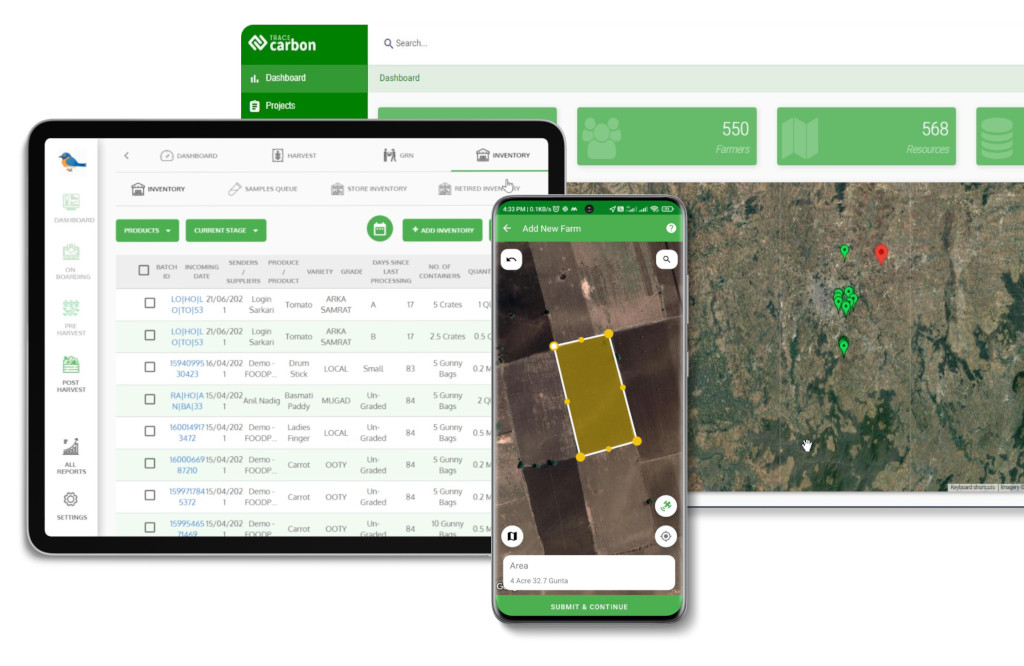Contact: +91 99725 24322 |
Menu
Menu
Quick summary: Discover the importance of sustainable agriculture land management in promoting environmental conservation and long-term productivity. Explore strategies, best practices, and innovative approaches to enhance soil health, preserve biodiversity, and mitigate climate change.

Sustainable agriculture land management practices are essential for ensuring that we can continue to produce food while also preserving our planet’s natural resources. By adopting sustainable farming techniques, we can maintain or increase yields while reducing negative environmental impacts and promoting the overall sustainability of the agricultural sector.
According to FAO, unsustainable land use practices such as deforestation, intensive agriculture and grazing have led to a loss of about 24% of global land productivity.
Sustainable agriculture land management is an essential approach to farming that aims to promote long-term sustainability by preserving natural resources, increasing productivity, and ensuring food security. This approach involves the use of practices that minimize negative environmental impacts while maintaining or increasing yields. In this essay, we will discuss the importance of sustainable agriculture land management in promoting environmental preservation, economic benefits, food security, biodiversity conservation, and climate change mitigation.
Sustainable agriculture land management is of great importance as it promotes environmental preservation, economic benefits, food security, biodiversity conservation, and climate change mitigation. By adopting sustainable farming practices, we can ensure that we can continue to produce food while preserving natural resources and promoting the long-term sustainability of the agricultural sector. Therefore, it is essential that governments, farmers, and other stakeholders work together to promote sustainable agriculture land management practices and ensure a reliable food supply for future generations.

Sustainable agriculture land management is of great importance for several reasons:
Environmental preservation: Sustainable agriculture land management practices promote environmental preservation by reducing soil erosion, preserving water resources, maintaining soil health, and reducing greenhouse gas emissions
Climate change mitigation: Sustainable agriculture land management practices can help mitigate climate change by reducing greenhouse gas emissions and sequestering carbon in the soil. This approach can contribute to global efforts to reduce carbon emissions and promote climate resilience.
Sustainable Agriculture Land Management Practices
One of the most critical sustainable agriculture land management practices is crop rotation. Crop rotation involves alternating crops in a specific field each year to improve soil health, reduce pests and diseases, and increase yields. By rotating crops, farmers can reduce the buildup of soil-borne pests and diseases and improve soil fertility. Additionally, different crops have different nutrient needs, so crop rotation can help balance soil nutrients and reduce the need for synthetic fertilizers.
Another important sustainable agriculture land management practice is cover cropping. Cover crops such as legumes, grasses, or clovers are planted to improve soil health, reduce erosion, and increase soil fertility. Cover crops help reduce soil compaction, which improves water infiltration and allows plant roots to penetrate deeper into the soil. Additionally, cover crops can fix nitrogen from the atmosphere, reducing the need for synthetic fertilizers.
Conservation tillage is another sustainable agriculture land management practice that involves reducing or eliminating tillage to preserve soil structure, improve water infiltration, and reduce erosion. Tilling breaks up the soil structure, making it more susceptible to erosion and compaction. By reducing or eliminating tillage, farmers can maintain soil health and reduce the need for synthetic fertilizers.
Integrated pest management is also critical farmland land management practice. Integrated pest management involves using a combination of biological, physical, and chemical methods to manage pests while minimizing the impact on the environment. This approach includes techniques such as crop rotation, companion planting, and the use of natural predators and parasites to control pests.
Agroforestry is one of the climate smart land management practice that involves introducing trees or shrubs into agricultural landscapes to improve soil health, reduce erosion, and provide additional income streams. Trees and shrubs can provide shade and reduce soil moisture loss, improving soil health and reducing the need for irrigation. Additionally, trees and shrubs can provide fruits, nuts, and other products, creating additional income streams for farmers.
Water management is also critical for land management. Practices such as drip irrigation, rainwater harvesting, and water-efficient crop selection can help conserve water resources. By reducing water use, farmers can reduce the pressure on water resources and improve the overall sustainability of agriculture.
Finally, regular soil testing is essential for sustainable agriculture land management. Soil testing can help farmers determine nutrient content and make informed decisions about fertilization. By using soil testing, farmers can reduce the amount of synthetic fertilizers they use, saving money and reducing the negative environmental impacts of fertilizer use.
Why Status Quo?
Sustainable agriculture land management is becoming increasingly important as we work to address climate change, protect natural resources, and feed a growing global population. However, implementing sustainable agriculture practices comes with several challenges that must be addressed in order to ensure their success.
Despite these challenges, many farmers and organizations are making progress towards sustainable agriculture land management, recognizing the long-term benefits it can provide for both the environment and their businesses. Addressing these challenges will require collaboration and investment from governments, NGOs, and the private sector to provide farmers with the resources and support they need to implement sustainable agriculture practices effectively. This can include investments in infrastructure, training and education programs, and the development of new technologies and practices that can help the smallholder farmers adapt to changing environmental conditions.
TraceX Carbon being a future-ready platform can also help in the adoption of new technologies and practices that can help farmers adapt to changing environmental conditions. This can help address the challenge of climate variability and ensure the long-term sustainability of agricultural systems. The sustainability and carbon management helps farmers and organizations to capture the various sustainability metrics like soil health, water usage, biodiversity and incomes , baseline them and continuously monitor and report the parameters.
The platform enables efficient tracking of sustainability performance, including carbon footprint management, which helps identify emission hotspots and reduction opportunities. Regulatory compliance and reporting process are streamlined, while resource optimization and cost savings are achieved through identifying opportunities and waste reduction in food production.
Conclusion
Sustainable Agriculture Land Management practices such as conservation agriculture, agroforestry, and organic farming can help to improve soil health and promote sustainable farming practices. Additionally, the use of technology such as precision agriculture, crop rotation, and cover crops can also help to improve soil health and promote Sustainable Agriculture.
It is important to recognize that Sustainable Agriculture is not a one-size-fits-all solution. Different regions, climates, and farming systems require tailored approaches to ensure sustainable land use and soil health. Furthermore, collaboration among different stakeholders, including farmers, policymakers, scientists, and consumers, is necessary to achieve Sustainable Agriculture.
